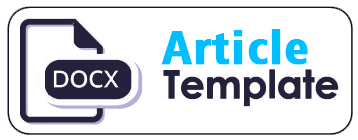PENGARUH LITERASI KEUANGAN TERHADAP KEBERLANGSUNGAN UMKM DI SEMARANG
Keywords:
Literasi Keuangan, Keberlangsungan, Kinerja, UMKMAbstract
In Indonesia, there are many MSMEs that don't know much about Financial Literacy, so many have difficulty getting capital and end up going bankrupt. This research uses quantitative methods with descriptive research type.
Sampling was carried out using a non-probability sampling method, saturated sampling type, with the number of respondents studied being 37 MSMEs. Based on a simple linear test by testing the hypothesis, financial literacy influences the sustainability of MSMEs. This is shown by the t table test result = 2.305 and the calculated t result is 5.825. So the calculated t is greater than the t table (5.825 > 2.305) which means that financial literacy has a significant effect on business sustainability.
References
Anggraini, D., & Nasution, S. H. (2013). Peranan Kredit Usaha
Rakyat Bagi Pengembangan UMKM di Kota Medan (Studi
Kasus Bank BRI). Jurnal Ekonomi Dan Keuangan, 1(3), 105”“116.
Anggraeni, B. D. (2015). Pengaruh Tingkat LiteFrasi Keuangan pemilik Usaha Terhadap Pengelolaan Keuangan. Jurnal Vokasi Indonesia. Vol. 3, No. 1.
Aribawa, D. (2016). Pengaruh literasi keuangan terhadap kinerja dan keberlangsungan UMKM di Jawa Tengah. Jurnal Siasat Bisnis (JSB). Vol 20, No. 1.
Ediraras, D. (2010). Akuntansi dan Kinerja UMKM. Jurnal Ekonomi Bisnis, Vol 15 (2), 152-158. OJK. (2013). Literasi Keuangan.
https://www.ojk.go.id/id/kanal/edukasi-dan- perlindungan-konsumen/Pages/Literasi-Keuangan.aspx
Risnaningsih. (2017). Pengelolaan Keuangan Usaha Mikro dengan Economic Entity Concept. Jurnal Analisa Akuntansi dan Perpajakan, Vol 1 (1), 41-50.
Suci, Y. R. (2017). Perkembangan UMKM Di Indonesia. Jurnal Ilmiah Cano Ekonomos. Vol. 6, No.1
Sugiyono. (2014). Metode Penelitian Kuantitatif, Kualitatif dan R&D. Bandung: Alfabeta. Cet. 20.
Downloads
Published
Issue
Section
License
The copyright of the received article shall be assigned to the journal as the publisher of the journal. The intended copyright includes the right to publish the article in various forms (including reprints). The journal maintains the publishing rights to the published articles.

This work is licensed under a Creative Commons Attribution 4.0 International License.






